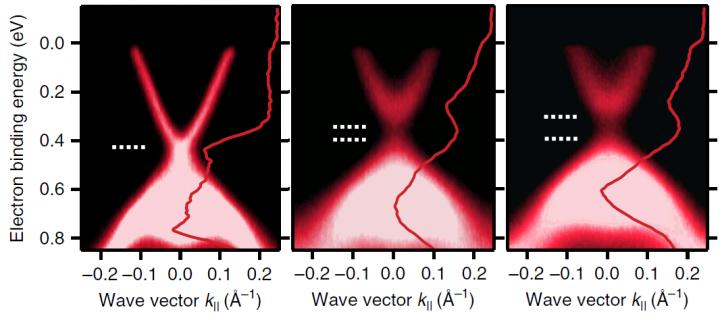
Topological Insulators: Magnetism and Conductivity Explained

In pure bismuth-selenide (left) no bandgap is found. With the addition of magnetic manganese (4 percent; 8 percent), a band gap (dashed line) arises, and electrical conductivity disappears. This effect shows even at room temperature.
Credit: HZB
Topological insulators are therefore highly conductive at their surfaces and electrically insulating within. Only magnetic fields should destroy this mobility, according to theory.
Now physicists headed by Oliver Rader and Jaime Sánchez-Barriga from HZB along with teams from other HZB departments, groups from Austria, the Czech Republic, Russia, and theoreticians in Munich have disproved this hypothesis.
They investigated samples for this purpose made of bismuth-selenide – a classic topological insulator – built up from enormous numbers of extremely thin layers, like puff pastry. These samples were doped with the magnetic element manganese (Mn), forming (Bi1_xMnx)2Se3 with various concentrations of Mn.
Theoretically, what is known as a band gap should have opened between the allowed electron states as a result of doping with magnetic impurities so that the previously conductive surface becomes insulating. As a result of the appearance of the band gap, the electrons also regain part of their mass. The magnetism of the impurities should be the critical influence in this process.
Theory disproved: Magnetism is not influencing the mobility of electrons
The physicists were able to actually detect the formation of a band gap in the doped samples. The mass of the electrons climbed from zero to one-sixth the mass of free electrons. They showed, however, that this band gap is not the result of ferromagnetic ordering in the interior or at the surface of the material, nor of the local magnetic moments of the manganese. The band gap formed independent of the strength of the magnetisation and even when the sample was doped with nonmagnetic impurities.
“We even measured surface band gaps that are ten times larger than the theoretically predicted magnetic band gaps, and actually independent of whether we had incorporated magnetic or nonmagnetic impurities”, says Jaime Sánchez-Barriga.
Instead, they suggest an entirely different process in these samples that causes the band gap at the Dirac point: with the help of what is known as resonant photoemission spectroscopy, they were able to observe scattering processes that might be responsible for opening a band gap. The fundamental properties of topological insulators do not offer many possibilities for these kinds of scattering processes. The researchers think it is conceivable that the presence of the impurities enables the electrons to leave the surface and disappear into the bulk.
“It is always more interesting for experimentalists like us, of course, when the experiment does not confirm the theoretical expectation. This band gap is considerably larger than predicted by theory and additionally involves a different causal mechanism. In order be sure that we are not mistaken, we used the entire arsenal at BESSY II, such as photoelectron microscopy and magnetic fields up to seven tesla. This enabled us to really preclude magnetism occurring as a possible cause down to roughly the nanometre scale”, explains Oliver Rader.
Two conclusions can already be drawn from this work: on one hand, that topologically shielded states are still far from being completely understood. On the other, it means that problems previously overlooked are now in the spotlight. How can scattering processes be minimised by the choice of magnetic impurities? And what is the role of lattice location of the impurities in the host? Since Topological insulators are promising candidates for new information technologies, those questions should be explored in depth.












